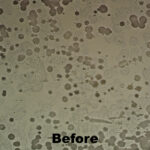Description
Our Repair
We’re happy to announce that, like the M9 series, we can now also repair the Leica S sensor and replace it with corrosion resistant glass starting at $1999. We’re able to delaminate the corroded filter from the sensor, and replace it with BG39 glass and BG61 glass. This glass will last indefinitely without oxidizing per Schott test reports.
PLEASE NOTE: Orders placed without rushed processing can be expected to take approximately 3-4 weeks for completion once the camera has arrive with us.
BG61 vs the M9 Original Glass

We are now using a new BG61 glass with anti-reflective coated which is nearly an identical match to the original M9 glass filter. We designed the BG61 to be the same thickness as the original filter while also matching the transmission properties. This is a highly specialized glass made by Schott that is inherently corrosion resistant, even before we put an additional protective anti-reflective and anti-smudge coating to seal from the environment. This filter cannot corrode by design, even if the coatings get scratched.

We also offer a cheaper BG39 glass with a protective anti-reflective and anti-smudge coating to seal it against corrosion. We offer this option with a lifetime guarantee against corrosion. We have this available right now at a lower price to the BG61. Color and optical performance is virtually identical to the BG61 glass, however this glass may corrode over time if the coatings get scratched or worn off.
Disclaimer:
Please note: below is our disclaimer for the Leica M9 series which also applies to the Leica S Typ 006 camera.
When working with corroded equipment, there’s a high degree of risk outside of our control when performing repair services. Most of the Leica M9’s we receive suffer from a heavily damaged ICF that may crack when being removed from the sensor assembly. We’ve also seen Leica M9s arrive with an already cracked ICF due to the corrosion issue. We’re a highly skilled and capable repair shop but unfortunately, there isn’t much we can do to avoid this even under extreme care. If your sensor cracks during removal there is a chance that glass dust can land on the bare sensor which can cause fine scratches that can be visible under some shooting settings.
Furthermore, we’ve been seeing that almost all M9’s with CCD ID5 sensors are also affected by a liquid gel substance. We believe it stems from the glass adhesive that can leak onto the sensor and corrode through bond wires. This liquid gel is visible under a microscope but can’t always be seen by the naked eye.
We found that even with 1-3 corroded wires, the M9 typically works without any noticeable issues after being repaired but we cannot guarantee this for every camera. If we see 1-3 corroded wires, we will continue with the repair like normal. If we see more than 3 corroded wires, we will stop the repair and let you know before proceeding.
We cannot be held liable for damages if the liquid gel spreads to your bare sensor or other bond wires during the repair service. We are also not liable for any liquid gel or electronic issues stemming from corroded bond wires after the repair service is completed in the event that it is not visible during the repair.
We don’t see gel issues with M9, M-E, or M9-P models with CCD ID11 as the glue used on these sensors is different. However with CCD11 sensors, we do see a high prevalence of cracked sensor glass. The CCD11s are more likely to crack and leave fine scratches on the sensor after the modification.
If you’d like to check what kind of sensor your Leica M9 has, you can do so by following the prompt below:
1. Enter the menu.
2. Press delete -> up (2x) -> down (4x) -> left (3x) -> right (3x) -> Info – This button combination will enter the camera into debugging mode.)
3. Select Hardware ID. Your sensor type will be the first option under this menu.
Lastly, some repairs are not possible (or very high risk) because of an extremely strong bond that can not be softened for a safe filter removal. When we receive your camera, we will perform a full evaluation and see if the repair is feasible, and if there are any digital issues, or issues that will make your sensor repair high risk (for example existing cracks in the sensor glass, gel issues, etc). If we find that we cannot repair your camera, or consider it a high risk repair, we will stop the repair process, reassemble your camera, and notify you for approval to continue with the repair or return the camera as-is. In the event that we can not move forward with your repair for any reason, we will return your camera and process a refund for your repair minus fees. Fees include a $100 evaluation fee, a 5% processing fee, and return shipping costs.
We’ve also been noticing that some Leica sensors are affected by electronic failure. Unfortunately, this repair will not fix this. You will need a complete sensor replacement. This issue is typically caused by a corrosive gel that can dissolve the sensor bond wires. Here’s an example of what electronic sensor failure looks like below:

By purchasing you agree to our Terms of Purchase.

















Reviews
There are no reviews yet.